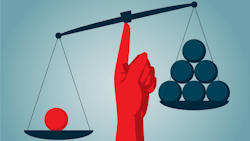Content brought to you by Professional Distributor. To subscribe, click here.
I’ve been so very lucky in my selling career to have been associated with some of the greatest tool companies. Klein Tools, Witte Tools, Stanley, KNIPEX, Ajax Tools, and BETA Tools. At all these terrific companies I had many executive duties but none of these duties were more important than my sales responsibilities. Selling and sales team development skills are why they hired me.
This is no different than being a mobile jobber. Yes, you have finance, inventory, truck maintenance, insurance, and probably a bunch more responsibilities that I am not aware of, but none of these are more important than getting out there every day selling your stuff.
Since you have all those non-fun duties to take care of, you had better make the most of the selling time you do have by giving great demonstrations and closing every day, all day.
A “selling benefits” attitude
Giving great demonstrations all day, every day is a frame of thought. Whether you’re presenting a single 4” Phillips screwdriver or a $15,000 tool storage system. A benefit-driven frame of mind will provide you with demonstrations that sell.
However, there is a world of difference between the demonstration of a screwdriver and the demonstration of a huge tool storage system. There are demonstrations, and there are demonstrations. Developing a “selling benefits” attitude will help you be successful with both.
A selling benefits frame of mind comes easily to some people and not so easily to others, but it is available to anyone who sets their mind on sales success.
Simply said, work on getting your mind set on following every feature/detail you present to a customer with why that feature is a benefit to them personally.
- Feature: This is a 75,000 BTU furnace.
- Advantage: This furnace is reliable and works well.
- Benefit: It keeps you and your family warm and comfy on cold winter nights.
The feature is simply what it is—it is a Streamlight Switchblade Worklight. The advantage is what the feature does—it provides precise lighting or illuminates large areas. The benefit is what the features and advantages mean to the user you are speaking to—you will be able to see better to safely work harder, faster, and longer, or you’ll be able to find those small nuts and bolts you drop while you’re working.
Sure, the advantage is important. Having a well-lit work area is essential but all good quality lights will light your work area. This light, however, will allow you to work safer, longer, and harder which is a benefit to that individual customer.
- Feature: The screwdriver blade has a forged-in wide end that is injection molded into the handle.
- Advantage: The blade will never twist in the handle, pound through, or pull out.
- Benefit: This screwdriver will be stronger and last you a lifetime.
If you go into every situation with a “benefit selling” frame of mind it will soon become second nature.
What’s in it for your customer?
As you hand out your company’s monthly brochure don’t just say, "Here is the brochure of all our current specials.” Say something like, “Here is our current brochure of specials which contains some of our most interesting and new products. Purchasing these this month will help you save money, which is always a good thing, isn’t it?”
It is almost never a good idea to tell a customer that buying this will help you win some contest or qualify for some increased benefit. They may like you, but their primary care is what’s in it for them.
It is unfortunately easy to slip into “advantage” selling and neglect “benefit” selling. As in the example below.
- Feature: This is our cool, red dead blow hammer.
- Advantage: When you hit something the beads inside will slam forward to force the impact on your target and absorb the impact so the hammer will never bounce off what you are hitting.
So, in this example, you might make the sale with just the feature and the advantage, but the benefit will assuredly close the deal as the benefit shows your customers what's in it for them.
- Benefit: In addition to not damaging anything around what you are hitting, this dead blow hammer will not bounce off your target and injure you.
Demonstrations vs. demonstrations
Now, back to the difference between demonstrations and demonstrations.
With the quick demo of a simple product, like our dead blow hammer, there are probably three or four features/benefits to hit on that will close the deal. If your customer needs to replace their hammer, then your dead blow hammer will almost sell itself. Just be sure to follow those three to four features with the benefit those features have for that individual.
However, the demonstration of the massive tool storage system needs to be thought through in advance—planned, staged, and professionally executed.
Set the stage by inviting the prospect onto your truck where you can close the door to create a quiet environment allowing both you and the prospect to focus 100 percent on this potential sale. If you have a cup of coffee or a soda available be sure to offer it to your prospect. The objective is to get the individual relaxed and focused on you.
Present your tool storage system in logical order. Maybe start at the bottom (wheels) and work up. Wheels, slides, drawer sizes, the material, etc. Do not begin with your best and most important features. You want the prospect to get comfortable with your feature, advantage, benefit, and trial close pattern. You want them to get in the habit of agreeing with your trial closes that these benefits are good for them. Your objective is to get the prospect in the habit of saying yes. If you hit them with the best and most important benefits first, you will run out of things to talk about pretty quickly.
Never ever hand the prospect a piece of literature or a catalog until the end of your presentation or at least only when you have something you must show them in the literature. And once you’ve shown that feature, take the literature back from them until the end of your presentation.
It is a sales skills fact that as soon as you hand the prospect some literature, they go deaf, start looking at the literature, and quit listening to you.
Be prepared for the normal questions and objections. Build them into your presentation so you answer them before the customer has a chance to ask them. This way you control the question and can shape the answer to your product’s benefit.
- Feature: Our storage unit side is made of XX-gauge steel.
- Advantage: We’ve been manufacturing high-end storage systems for 50 years and our engineers design our products to have the perfect strength and weight steel to fit a professional’s needs.
- Benefit: I imagine you agree that is the best way to manufacture a great system, don’t you?
The above is a lot better than having the prospect say, “The other system I’m looking at uses XXX-gauge steel, why don’t you?
In the end, the more you can impress your prospect that this product is going to benefit them personally the easier it will be to close the sale.
Now, go sell something!
About the Author

Alan Sipe
President, Toolbox Sales and Consulting
Alan W. Sipe has spent the last 42 years in the basic hand tool industry including positions as President of KNIPEX Tools North America, Sr. VP Sales and Marketing at Klein Tools, Manager Special Markets at Stanley Tools and sales management at toolbox manufacturer Waterloo Industries. Currently Sipe is the owner of Toolbox Sales and Consulting specializing in sales strategy, structure, development and training. Sipe can be reached at [email protected] or 847-910-1063. Connect with Sipe on LinkedIn.
